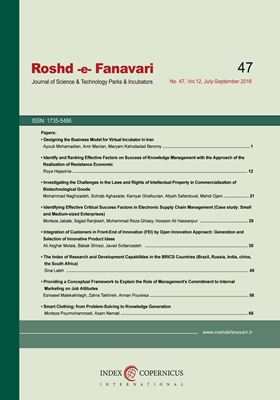-
-
List of Articles
-
Open Access Article
1 - Designing the Business Model for Virtual Incubator in Iran
Amir Maniyan Maryam Khodadad Barmi Ayob Mohamadian -
Open Access Article
2 - Identify and Ranking Effective Factors on Success of Knowledge Management with the Approach of the Realization of Resistance Economic
Roya Hejazi Nia -
Open Access Article
3 - Investigating the Challenges in the Laws and Rights of Intellectual Property in Commercialization of Biotechnological Goods
Sohrab Aghazadeh Kamyar Ghaforian atiyeh safardoust Mahdi Ojani Mohammad Naghizadeh -
Open Access Article
4 - Identifying Effective Critical Success Factors in Electronic Supply Chain Management (Case study: Small and Medium-sized Enterprises)
morteza jabale Sajad Ranjkesh Mohammad Reza Ghiasy Hossein Ali Hassan pour -
Open Access Article
5 - Integration of Customers in Front-End of Innovation (FEI) by Open Innovation Approach: Generation and Selection of Innovative Product Ideas
Ali Asghar Molaie Babak Shirazi Javad Soltanzadeh -
Open Access Article
6 - The Index of Research and Development Capabilities in the BRICS Countries (Brazil, Russia, India, china, the South Africa)
Sina Laleh -
Open Access Article
7 - Providing a Conceptual Framework to Explain the Role of Management's Commitment to Internal Marketing on Job Attitudes
Esmaeil Malek Akhlagh Zahra Takhire Arman Pourusa -
Open Access Article
8 - Smart Clothing; from Problem-Solving to Knowledge Generation
Morteza PourMohammadi Azam Neumati
-
The rights to this website are owned by the Raimag Press Management System.
Copyright © 2017-2026







